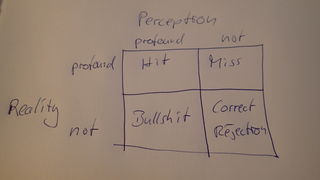Bias
Not Even Bullshit
Between the manifest and the unmanifest, there is bullshit.
Posted December 6, 2015

The source of all creation is pure consciousness . . . pure potentiality seeking expression from the unmanifest to the manifest. And when we realize that our true Self is one of pure potentiality, we align with the power that manifests everything in nature. ~ D. Chopra
As the paper by Pennycook et al. (2015) is making its viral rounds, we learn about the power of bullshit over the common mind. Philosopher Harry Frankfurt’s (2005) slim volume ‘On Bullshit’ made the term salonfähig (fit for use in polite conversation). When I use the word ‘bullshit’ in front of an academic or a collegiate audience, I always make clear that I am using it in Frankfurt’s sense. Frankfurt’s main point was a definitional one: he took pains to distinguish bullshit from mere lies. A lier knows and deliberately violates the truth. A bullshitter does not care. Hence, some bullshit may actually be true. What matters is the bullshitter’s attitude, his or her indifference to truth. Truth in bullshit – when it occurs – is incidental.
Pennycook et al. found evidence for bullshit receptivity and bullshit sensitivity. Receptivity refers to an overall inclination to accept statements as profound. Sensitivity refers to the ability to discriminate between pseudo-profound bullshit and genuinely profound statements. Much as Pennycook et al.’s effort to discriminate between receptivity (bias) and sensitivity (ability to detect) is to be applauded, they did not do a good job keeping these two aspects of bullshit vulnerability conceptually and statistically separate. Here’s what they did:
To measure bullshit receptivity, they generated 10 Deepak-Chopra-esque statements, suspended between vacuity and spirituality. On a 5-point profundity scale, the correct response would arguably be a 1 (not profound). Any rating higher than that indicates receptivity to bullshit. To measure bullshit sensitivity, they subtracted for each respondent the mean profundity rating for the Chopra statements (“Imagination is inside exponential space time events”) from the mean profundity rating on a set of motivational statements (“A wet person does not fear the rain.”). Since the measure of sensitivity is the difference between A [motivational statements] and B [bullshit statements] it is not surprising that the two measures yield similar patterns of correlations with other individual difference measures of interest, but with different signs. Receptivity (sensitivity) is positively (negatively) correlated with a measure of paranormal belief, whereas the reverse is true for the correlation with a measure of analytical thinking.

A signal-detection analysis would have been more informative. In such an analysis, reality (profundity vs bullshit) is crossed with perception (profound vs bullshitty). If a statement is profound and we see it that way, we have a Hit (H). If a statement is profound and we think it is not, we have a Miss (M). If a statement is not profound and we recognize that it is not, we have a Correct Rejection (CR). Finally, if a statement is not profound but we think it is, we have a False Positive (FP) error; we are victims of bullshit. In such a framework, receptivity (or bias) is – simply speaking – the overall prevalence of H and FP relative to M and CR, whereas sensitivity (or detection) is the prevalence of H and CR relative to M and FP. Pennycook et al. obscured the relationship between bias and detection, although I don’t think this lapse justifies the charge that they are bullshitting us.
Let’s take a closer look at the statements Pennycook cooked up by remixing Chopra’s raw materials. Following Shermer (2010), Pennycook et al. regard Chopra’s pronouncements as “woo-woo nonsense.” What proportion of Chopra’s writings falls under this rubric is unclear, but presumably all statements that made it into the bullshit scale are of this variety (they have to be). If Chopra is a bullshitter in the tradition of those analyzed by Frankfurt, he would on occasion, if unwittingly, speak the truth. In the statements selected to measure bullshit receptivity he does, by design, not. These statements, by the way they have been selected or generated, cannot be true. Hence, they cannot even be false. And therefore, they cannot be bullshit. By lying outside of the truth-falsity spectrum, the charge of bullshit misses the point. But this does not spell good news for Deep Ack. Statements as used by Penycook et al. or the epigraphic statement of this post are gibberish.

I submit that gibberish be studied by philosophers and psychologists. We need a Frankfurt to write a philosophical treatise On Gibberish, and a Pennycook and his sous chefs to do empirical research on gibberish receptivity and detection (using a signal-detection framework). Dictionary.com defines gibberish as [1] “meaningless or unintelligible talk or writing,” or [2] “talk or writing containing many obscure, pretentious, or technical words.” Put together, [1] and [2] capture much of what Chopra and writers of his ilk use to contaminate the popular mind.
Pennycook et al. raise an important question: Why is it that many people subscribe to gibberish and bullshit? Their finding that bullshit/gibberish vulnerability is correlated with other cognitive weaknesses is a first clue. Bullshittees (their term) and gibberishees (my generalization) have little willingness for, or training in, critical thinking. This is a start, but I doubt that it is the whole story. I suspect that once you are clued into the nature of bullshit and gibberish, you can spot it without much effort, even if you are ‘cognitively busy.’ More work needs to be done, and Pennycook et al. have pointed the way.
Note. The photo at the top shows the statue of Ganeesha I keep in my house. Ganeesha represents good beginnings. I like Ganeesha.
Another note. If you'd like to read more about Chopra, D., from a non-chopra-esque point of view, I recommend the entry in the Skeptic's Dictionary.
And yet one more. Pennycook et al. cite a delightful essay by French philosopher Dan Sperber, which I also recommend as additional reading. In "The guru effect," Sperber (2010), shows how the delivery of obscure, hard-to-understand, verbiage can further enhance a writer's reputation all the way to guru-dom if his (usually his) reputation as a deep think is already established. The audience is then likely to assume that that their own futile efforts at understanding signal the presence of deep meaning that he, the guru, comprehends, and which cannot be conveyed in simpler terms. Sperber is not so much concerned with the gibberish artists of the Deepak variety, but with certain 'continental' philosophers (les maîtres à penser) among whom he has lived. He gives several examples, and I like this one in partcular: "Consciousness is a being, the nature of which is to be conscious of nothingness of being." Guess who wrote this. And tell us, is this pseudo-profound bullshit, gibberish, simple illogic (tautology), or all of the above. What can one do to become one with it?
Frankfurt, H. G. (2005) On bullshit. Cambridge: Cambridge University Press.
Pennycook, G., Cheyne, J. A., Barr, N., Koehler, D. J., & Fugelsang, J. A. (2015). On the reception and detection of pseudo-profound bullshit. Judgment and Decision Making, 10, 549-563.
Shermer, M. (2010). Deepakese: The Woo-Woo Master Deepak Chopra Speaks. http://www.huffingtonpost.
Sperber, D. (2010). The guru effect. Review of Philosophical Psychology, 1, 583–592.




